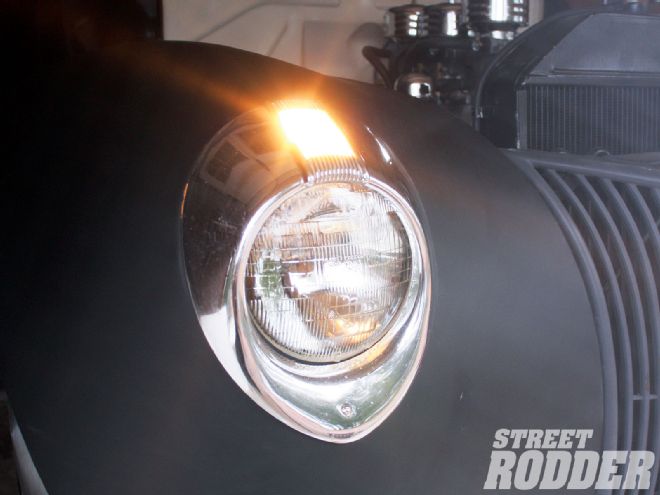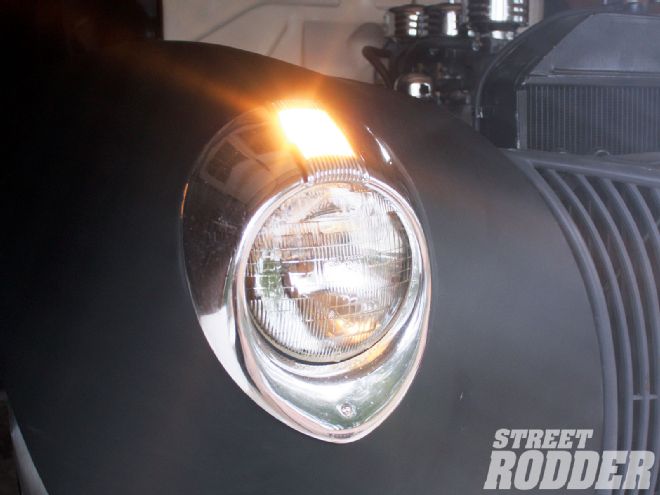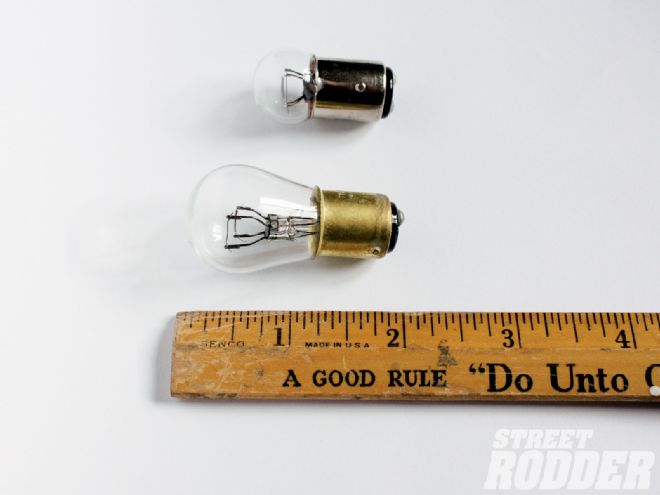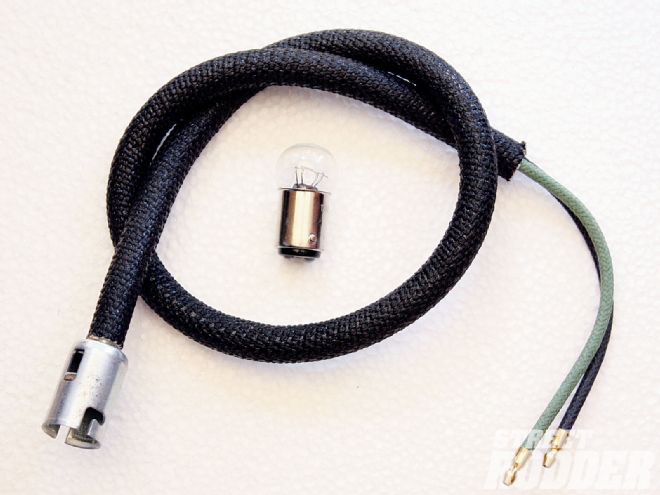
The Deuce has its iconic grille, but the '40 Ford has what are arguably the nicest headlights of the prewar era. That was the first year modern sealed-beam headlights were used on Fords, and designer Bob Gregorie found a beautiful way to shell them with a nacelle that incorporated parking lights on top. Even on the basic Fords where the headlight shells were painted body color, the shape blended nicely with the curvature of the front fenders. Ford did not refer to any of their models with the pedestrian name "Standard," there was the Ford and the Ford DeLuxe. Later restorers and hot rodders used the term Standard as a way to differentiate the less expensively trimmed Fords. Pickups and commercial vehicles also wore the painted trim shells, but most hot rodders liked the chromed ones, which could be swapped on with a screwdriver (only one retaining screw) in half a minute. Our '40 minutia maven, Dick Santana, tells us that many owners of '40 Standards switched to the chromed DeLuxe headlight shells as a dealer-installed option, so some restorers can be confused by '40 Standards with chromed shells yet with no other DeLuxe features.

Much as we love the design and execution of the 1940 Ford headlight arrangement, there was no provision on the cars for turn signals, just the park light under a white lens on top of the headlight shell. On production Fords, separate front turn signals didn't come along until after the war. With today's tight traffic and drivers who are only half-watching the road ahead while texting, it's vital to have bright, visible turn signals front and rear for our own protection. We owe this socket/bulb conversion idea to the clever "boys in the back room" at Sacramento Vintage Ford, specifically Ron Palmer, a 26-year veteran of the wiring harness department.
 The difference between a standard No. 1157 taillight bulb (bottom) and the squatty round one from Sacramento Vintage Ford is dramatic, and the installation is simple. Our retro '40 has front turn signals as bright as brake lights and yet shows no outward signs of being "modernized."
The difference between a standard No. 1157 taillight bulb (bottom) and the squatty round one from Sacramento Vintage Ford is dramatic, and the installation is simple. Our retro '40 has front turn signals as bright as brake lights and yet shows no outward signs of being "modernized."
Bob Gregorie's design tucked the shell down around the sealed beam so tightly that there was precious little room under the shell for the park light bulb up at the top, plus the bulb had to be located somewhat to the right side of the sealed-beam's bucket to clear the upper headlight adjusting screw, making for a weaker light for the park bulb through the centered white lens. It's a simple fact that dual-filament bulbs, such as a typical No. 1157 taillight bulb are way too big to fit under the '40 shells. Rodders have had the latitude to install any kind of accessory turn signals they wanted, but restorers who make up a large part of the clientele at Sacramento Vintage Ford did not have that option.
What the back-room boys came up with in their research was a source for a small, dual-filament bulb with a short, round head that could fit where no regular bulb could. It also had to fit one of their existing reproduction taillight sockets, which accept two-prong bulbs with staggered lugs (one lug lower than the other).
The installation mods are dead-simple. The hole in the upper part of the sealed-beam's bucket must be enlarged to 0.655 inch to accept the new dual-filament bulb socket, which you will solder in place. Clean the area around the new hole for a good contact, use steel wool to clean the outside of the socket, and use flux on the hole and the socket. You could also secure the socket with two-part epoxy if you're not comfortable with your soldering skills, but you will have to add a ground wire to the socket.
 Here's all you need for one headlight, the No. 06139 taillight socket and harness and the No. 13217 bulb. Sacramento Vintage makes restoration-correct Ford wiring harnesses, using modern wire with plastic insulation that is then sleeved with woven-cloth covering and the ends are finished with period brass contacts or terminals.
Here's all you need for one headlight, the No. 06139 taillight socket and harness and the No. 13217 bulb. Sacramento Vintage makes restoration-correct Ford wiring harnesses, using modern wire with plastic insulation that is then sleeved with woven-cloth covering and the ends are finished with period brass contacts or terminals.
Follow our pictures and captions and you'll see that this isn't rocket science. We know there's a bolt-on kit on the market to do this, but it's expensive and utilizes LED lights. Of course, LEDs are brighter for safety, but restorers and most traditional hot rodders don't care for the modern look of them. The entire cost of the conversion shown here is $22.90 for the two sockets and two of the special bulbs. We suggest you buy four bulbs, and stash two away in your glovebox as spares, wrapped in plastic for protection.